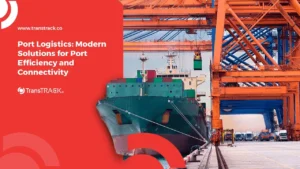Get to Know the Benefits, Roles, Strategies and Challenges of Green Logistic!
Posted on September 1, 2023 by Nur Wachda Mihmidati

Green Logistic, also known as Sustainable Logistics or Eco-friendly Logistics, refers to an approach in supply chain management that aims to reduce negative impacts on the natural environment while still meeting logistical and business needs. This concept involves implementing sustainable practices in all stages of the supply chain, from production to distribution of the final product.
Green Logistics provides multiple benefits, namely reduced environmental impact and operational efficiency which has the potential to reduce costs. With the increasing awareness of environmental issues, Green Logistics is increasingly becoming a major focus in the modern logistics industry. For more details, let’s look at the following TransTRACK article!
Benefits of Green Logistic for Business
Implementing Green Logistic can provide a number of important benefits for businesses, including:
Benefit Green Logistic: Cost Efficiency
Adopting sustainable practices in the supply chain can reduce long-term operational costs. For example, optimizing delivery routes and using more efficient vehicles can reduce fuel consumption and transportation costs.
Benefit Green Logistic: Reputation and Business Image
Businesses that implement Green Logistics are often perceived as more environmentally responsible by consumers, business partners and the general public. This can enhance a company’s image and reputation, help win customer trust, and differentiate a business from competitors.
Benefit Green Logistic: Regulatory Compliance
More and more countries are implementing regulations that require businesses to reduce their greenhouse gas emissions and other environmental impacts. By implementing Green Logistic, businesses can better meet these regulatory requirements, avoiding fines or sanctions that may be imposed.
Benefit Green Logistic: Product Innovation and Differentiation
Encouraging sustainable practices in supply chains can be a source of inspiration for greener product and service innovations. This could open up new opportunities to create products that are more desirable in a market that is increasingly concerned about the environment.
Benefit Green Logistic: Supply Risk Reduction
Reliance on scarce or limited resources can create supply risks. By adopting sustainable practices, businesses can reduce this risk by optimizing the use of resources and seeking more sustainable alternatives.
Benefit Green Logistic: Stock and Inventory Efficiency
Green Logistic can assist in more efficient stock and inventory management. Reducing waste and optimizing shipping can avoid overstocking or understocking, which in turn can save costs.
Benefit Green Logistic: Access to New Market
Some markets and customers are increasingly prioritizing environmentally friendly products and services. By implementing Green Logistics, businesses can meet these market requirements and open up opportunities to enter into new market segments.
Benefit Green Logistic: Resource Efficiency
By reducing the use of unnecessary energy, water and raw materials, businesses can reduce operating costs while reducing their environmental impact.
Benefit Green Logistic: Sustainable Partnership
Implementing Green Logistic can strengthen relationships with suppliers who are committed to sustainable practices. This can create a mutually beneficial long-term partnership.
By understanding these benefits, businesses can design Green Logistic strategies that suit their goals and values, creating long-term benefits that include economic, environmental and social aspects.
[display-post-read-also]
The Role of Green Logistic
Green Logistics has a significant role to play in promoting environmental and economic sustainability in supply chain operations. Following are some important roles of Green Logistic:
Greenhouse Gas Emission Reduction
One of the main roles of Green Logistics is to reduce greenhouse gas emissions from logistics activities, such as transportation and storage. By adopting more efficient vehicles, optimizing delivery routes and using renewable energy sources, Green Logistic is helping to reduce the impact of climate change.
Resource Conservation
Green Logistic focuses on the wiser and more efficient use of natural resources, such as energy, water and raw materials. These practices help to avoid wastage and overuse which can damage the environment.
Reducing Waste and Increasing Recycling
Green Logistic promotes waste reduction through packaging optimization, packaging reuse and recycling practices. This helps reduce the impact of waste and promotes a more sustainable product life cycle.
Optimization of Routes and Transportation
Green Logistics helps optimize transportation routes by considering time and fuel efficiency. This contributes to reducing operational costs and emissions, as well as reducing traffic congestion.
Technological Innovation and Practice
Green Logistic drives the adoption of advanced technologies such as the Internet of Things (IoT), data analytics, and geographic information systems to manage supply chains more efficiently. This creates opportunities for innovation in how businesses manage and optimize logistics processes.
Ongoing Partnerships and Collaborations
Green Logistics encourages collaboration between companies, suppliers and third parties in a joint effort to reduce environmental impact. This creates a sustainable partnership relationship that can strengthen each other in achieving environmental goals.
Awareness Raising and Education
Green Logistics helps increase awareness and understanding of environmental issues in the supply chain context. By educating employees, customers and business partners, Green Logistic encourages wider adoption of sustainable practices.
Provision of Sustainable Products
Green Logistic encourages the development and supply of more environmentally friendly products through better product designs, the use of less hazardous materials, and more sustainable product life cycle planning.
Compliance with Regulatory Requirements
Green Logistics helps businesses meet increasingly stringent environmental regulatory requirements. By following these regulations, businesses can avoid fines and sanctions, and build an image as law-abiding business people.
Sustainable Value Development
By integrating economic, environmental and social considerations, Green Logistics helps businesses create sustainable long-term value for all stakeholders, including the company itself, consumers and society.
Overall, the role of Green Logistics is to integrate sustainability principles into every aspect of the supply chain, with the aim of reducing environmental impact while maintaining business efficiency and profitability.
Strategy for Implementing Green Logistic
The strategy of implementing Green Logistics is an important step to reduce the environmental impact in logistics operations. The following is a further explanation of each strategy:
Optimizing Delivery Routes
Using mapping technology and data analysis, companies can plan more efficient delivery routes. This reduces travel distance, travel time and fuel consumption. This technology also enables real-time monitoring for quick adjustments in case of obstacles on the road.
Using Eco-Friendly Packaging
Adopting environmentally friendly packaging, such as recycled or biodegradable materials, helps reduce plastic waste and the environmental impact of packaging. The use of more efficient packaging designs can also reduce the use of raw materials.
Introducing Eco-Friendly Shipping Methods
Choosing more environmentally friendly shipping methods, such as consolidation or using sea or rail transport instead of air transport, can reduce the carbon emissions generated by transportation.
Reducing Waste and Increasing Energy Efficiency
Through process optimization, companies can reduce waste and unnecessary energy consumption. The use of renewable energy or more efficient technologies also helps reduce environmental impact. Better waste management and recycling practices also help reduce the impact of waste.
Using Technology and Information Systems
Information technologies such as transportation management systems (TMS) and supply chain management systems (SCM) allow companies to manage inventory, shipping and other operations more efficiently. This can reduce operational costs, emissions, and wastage of resources.
All of the above strategies can be applied in combination to achieve optimal results in Green Logistics efforts. It is important to remember that implementing this strategy requires commitment and support from multiple levels of the organization, as well as possible changes in existing business processes. The implementation of Green Logistics is a sustainable step, and the results will be seen over time as the positive impact on the environment and operational efficiency is further realized.
Challenges of Implementing Green Logistics
The implementation of Green Logistics does not always run smoothly and is faced with several significant challenges. Here is a further explanation of each challenge:
Limited Resources and Technology
Implementing Green Logistics can require investing in more efficient and environmentally friendly technologies. However, not all companies have sufficient resources to adopt new technologies or replace their transportation fleets with greener ones. The limitations of available technology can also be a barrier, especially if an eco-friendly solution is still under development.
Economic and Regulatory Barriers
Some Green Logistics practices may require higher upfront costs, such as investing in green vehicles or sophisticated information management systems. If environmental regulations are not sufficiently supportive, companies may also feel reluctant to change their operational processes. This challenge can be overcome with government support and fiscal incentives to encourage the adoption of sustainable practices.
Environmental Awareness and Cultural Change
Even though awareness of environmental issues is increasing, there are still companies and individuals who are not fully aware of the importance of practicing Green Logistics. Implementing cultural change in an organization can be challenging, as it can involve changes in the way people think, make decisions, and carry out day-to-day operations.
By addressing these challenges effectively, businesses can integrate Green Logistics practices into their operations, achieve environmental and economic benefits, and support long-term sustainability goals.
On the journey to a more sustainable future, we need to embrace innovation that supports the vision of Green Logistics. This is where the Logistic Service Integrator from TransTRACK comes in as a suitable solution. With a sophisticated and integrative platform, TransTRACK enables companies to streamline their logistics operations, optimize delivery routes, reduce waste and even monitor carbon footprints more efficiently.
Together with TransTRACK, let’s build a green, efficient and sustainable logistics future. Join the change. Join TransTRACK.
Recent Post
Topic :
 Bahasa Indonesia
Bahasa Indonesia









